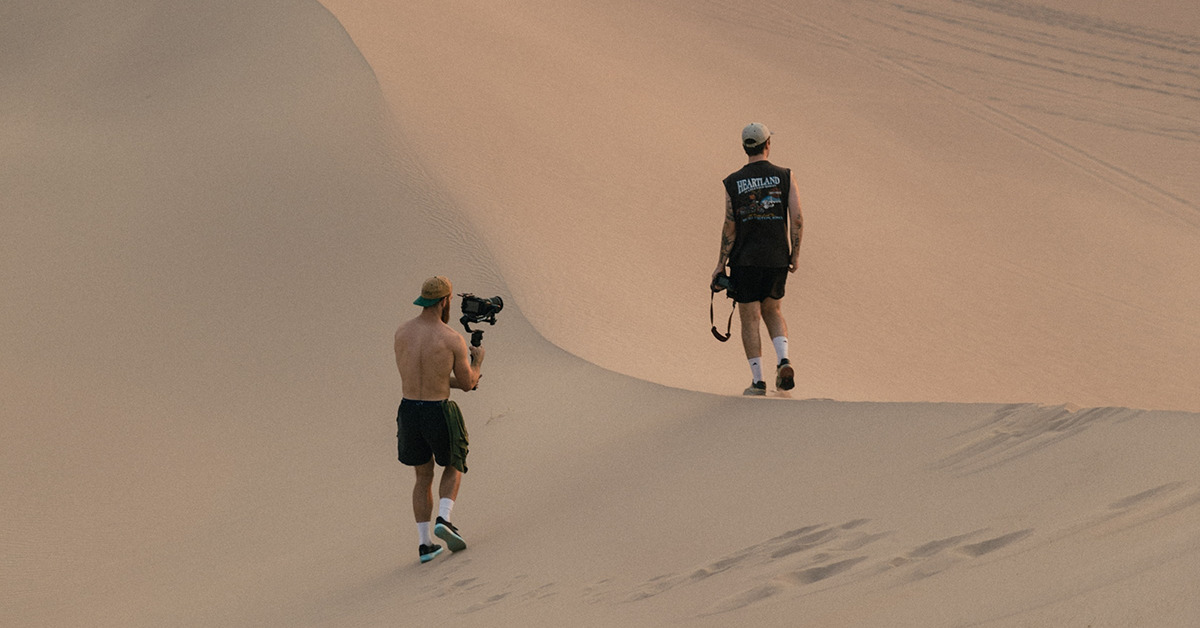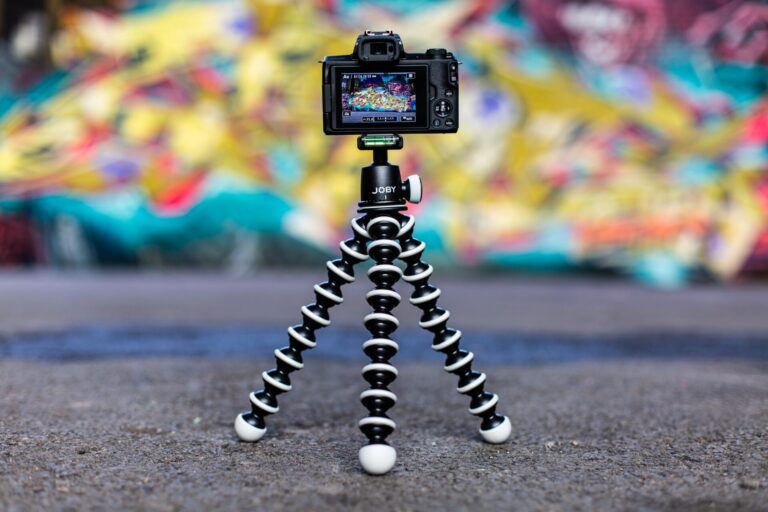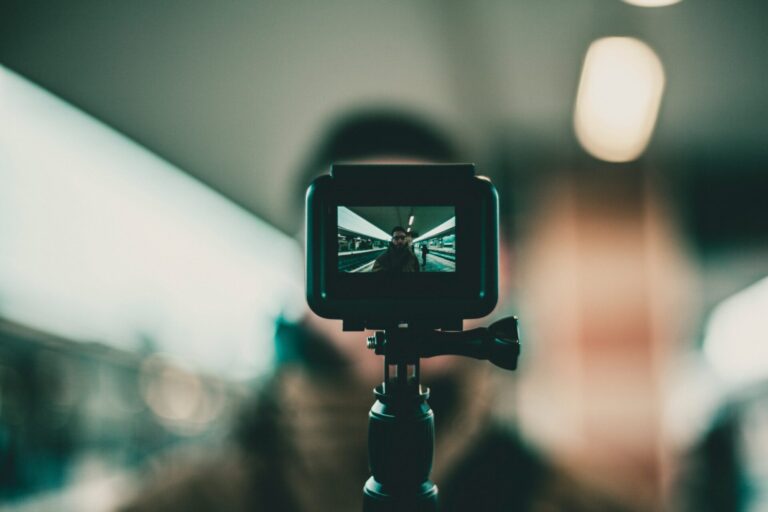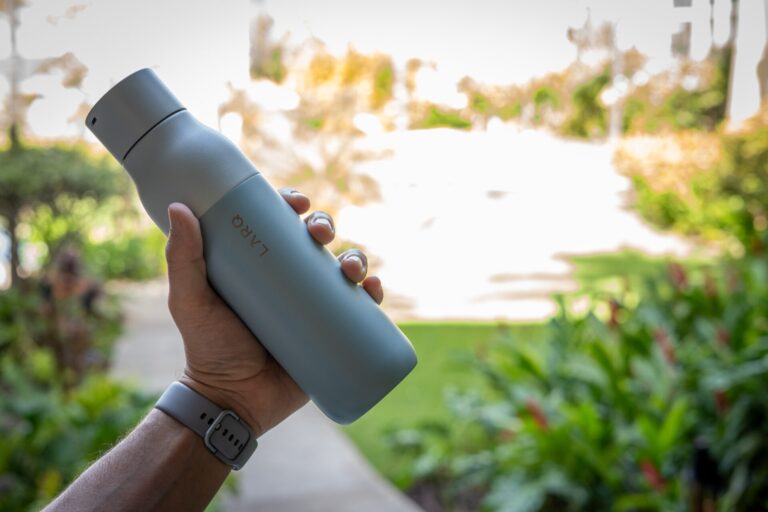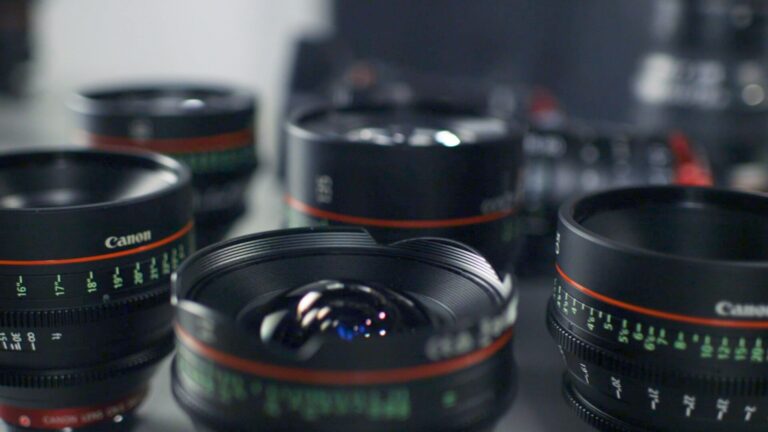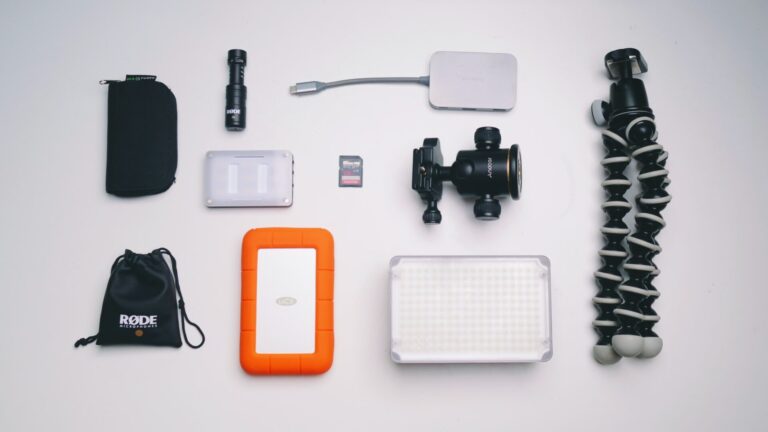The 7 Best Gimbal Camera Stabilizers for Traveling in 2024
Traveling and creating video content can be challenging, but using a gimbal camera stabilizer can significantly enhance the quality of your footage.
In this guide, we’ll showcase seven of the best gimbal camera stabilizers for creating content when you’re traveling in 2024. We’ll provide an overview of each gimbal’s features and capabilities, including their strengths and weaknesses.
We’ll also cover all the basics about gimbals, including how they work, their benefits, and key features to look for when choosing a gimbal. During our testing and reviews, we primarily used the Sony ZV-E10, and the Sony A7III cameras to provide a comprehensive overview of each gimbal’s capabilities. We wrote different guides specifically for Smartphone Gimbals and GoPro Stabilizers.
UPDATE JAN 2024: Our recent road trip across Morocco included testing the Hohem iSteady MT2, and we have revised this article to reflect our experiences.
Page Contents
Our top-rated Gimbal: Zhiyun Crane M2
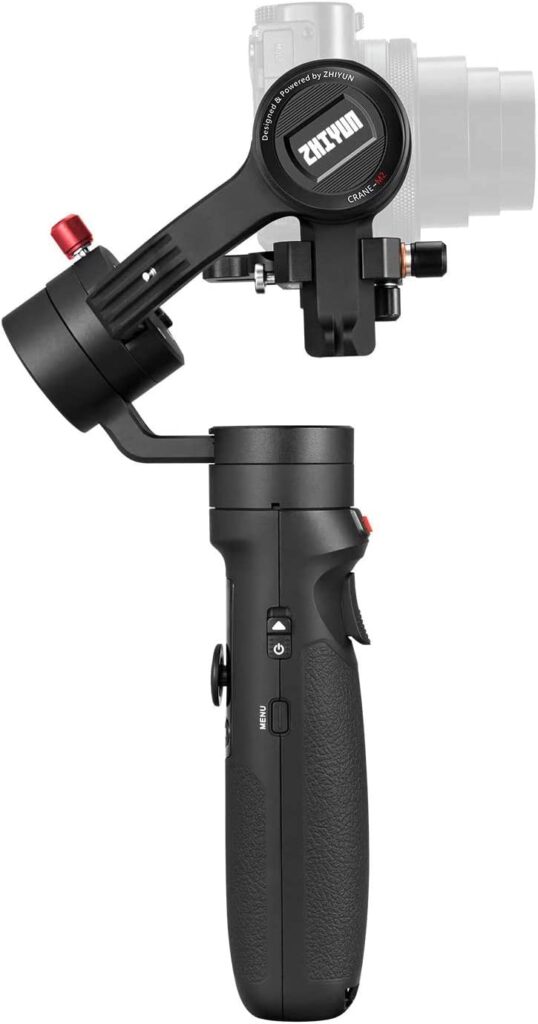
The Zhiyun Crane M2 is our favorite choice due to its compact size and lightweight design, weighing only 500g (1.1 lbs). Its payload capacity of 720g (1.58 lbs) can support a range of small mirrorless cameras and smartphones, making it a versatile option for capturing different types of footage on the go.
It also has a long battery life of up to 7 hours, allowing for extended shooting sessions without needing to constantly recharge. Additionally, it features various shooting modes and a built-in OLED display, providing greater control and convenience for capturing smooth, stabilized footage while traveling.
Price: $179,-
Why do people use gimbals?
People use gimbals to stabilize cameras and other devices to capture smooth and steady footage, especially when filming moving subjects or while in motion themselves. Gimbals help eliminate shakiness, vibrations, and unwanted movements that can occur when shooting handheld, providing professional-quality smooth, and stable footage.
What does a gimbal do in photography?
In photography, a gimbal stabilizes the camera and eliminates unwanted movements, providing smooth and stable footage. This is particularly useful when shooting moving subjects, such as sports or wildlife photography, as it allows the photographer to capture clear, crisp shots without blurring or shakiness.
What is a good Gimbal Camera Stabilizer?
A good gimbal camera stabilizer is essential for capturing smooth and steady footage, whether you’re a professional filmmaker or a casual videographer. There are several factors to consider when choosing a gimbal camera stabilizer, including build quality, stabilization capabilities, ease of use, and compatibility with your camera.
When it comes to build quality, you want to choose a gimbal camera stabilizer that is durable and well-constructed, with high-quality materials that can withstand the rigors of regular use. Look for gimbals made from lightweight but strong materials like carbon fiber or aluminum, with a comfortable grip and a secure mount for your camera.
Stabilization is also a key factor to consider, as this is the primary function of a gimbal camera stabilizer. Look for a gimbal that offers multiple axes of stabilization, such as three-axis or four-axis systems, which can provide smooth and steady footage even when walking or moving quickly.
Ease of use is another important consideration, as you don’t want to spend too much time fiddling with complicated controls or setup processes. Look for a gimbal camera stabilizer that is easy to set up and operate, with intuitive controls and a user-friendly interface. Some gimbals even have advanced features like automated tracking or programmable movements, which can help you get the perfect shot with minimal effort.
Finally, compatibility with your camera is essential, as not all gimbal cameras are designed to work with every type of camera. Check the gimbal’s specifications and ensure that it is compatible with your camera model and can support the weight and size of your camera and lens.
What are the different gimbal axes?
The pitch, roll, yaw, and vertical axes are the different axes of rotation that a gimbal can stabilize a camera along:
- Pitch – Tilting the camera up and down from the ground to the sky
- Yaw – Turning the camera side to side from left to right
- Roll – Tilting the camera so that the horizon of the image rotates
- Vertical – Related to the pitch axes: controls the camera’s movement along the vertical axis.
By stabilizing the camera’s movement along these different axes, a gimbal can provide smooth and stable footage even in challenging shooting conditions, such as while walking or moving in a vehicle.

What is the difference between a 2-axis and a 3-axis gimbal?
A 2-axis gimbal stabilizes the camera’s movement on two axes (usually pitch and roll), while a 3-axis gimbal stabilizes on three axes (pitch, roll, and yaw). This means that a 3-axis gimbal provides more stable footage and allows for more complex camera movements but may be heavier and more expensive than a 2-axis gimbal.
What is the difference between a 3-axis and a 4-axis gimbal?
A 3-axis gimbal stabilizes the camera’s movement on three axes (pitch, roll, and yaw), while a 4-axis gimbal stabilizes on four axes (pitch, roll, yaw, and vertical). This means that a 4-axis gimbal provides even more stable footage and allows for more complex camera movements but may be heavier, more expensive, and require more power than a 3-axis gimbal.
What’s the difference between a gimbal and a stabilizer?
A gimbal and a stabilizer are both devices used to stabilize a camera and reduce shake or vibration, but they work in different ways and have different features. Gimbals are generally more advanced and capable than simple stabilizers, as they offer more precise control and stabilization and can support more complex camera movements.
The gimbal devices use motors and sensors to keep a camera level and steady as it moves, allowing the camera to remain upright and steady even if the operator is walking or running. Gimbals typically have multiple axes of rotation, such as three-axis or four-axis systems, which allow the camera to move smoothly in all directions. Gimbals are often used for filmmaking, sports videography, and other applications where smooth, stable footage is required.
On the other hand, a stabilizer is a more general term that can refer to any device or technique used to stabilize a camera, including gimbals. However, stabilizers can also refer to simpler devices, such as handheld or tripod-based mounts, which help to reduce shake or vibration by providing a stable platform for the camera. Stabilizers can also include software-based stabilization techniques.
What to look for when buying a gimbal?
The type of gimbal that you need depends on how you plan to use it. For example, if you’re a travel photographer, you may need a portable and lightweight gimbal with a long battery life to capture stable footage while on the go.
On the other hand, if you’re a professional filmmaker, you may need a more advanced gimbal with a higher payload capacity and more advanced features, such as a follow-focus system or wireless control options.
What to look for when buying a gimbal for social media content?
For people focused on creating social media content, the most important factor to consider when choosing a camera gimbal may be its smartphone compatibility and ease of use.
Many social media content creators use smartphones to capture and share content, rather than traditional cameras. So, if you’re primarily using your smartphone for content creation, choosing a gimbal that is compatible with your device is important.
In addition, ease of use is also important, as social media creators may need to set up and use their gimbals quickly and easily while on the go. A gimbal that is easy to balance and operate can save time and frustration, allowing creators to focus on their content rather than the technical aspects of filming.
I would suggest looking for a gimbal that is easy to use and can help you create high-quality, engaging content that stands out on social media platforms.
What to look for when buying a gimbal for traveling?
For people focused on creating travel content, the most important factors to consider when choosing a camera gimbal may be its portability, battery life, and durability.
Travel content creators often need to move quickly and pack light, so a gimbal that is compact and easy to transport can be essential. Portability is also important for those needing to hike, climb, or move around in challenging environments.
In addition, battery life is a crucial consideration for travel content creators, who may not have access to power sources for extended periods. A gimbal with a long battery life can allow creators to film longer without recharging.
Durability is also important for travel content creators, who may face harsh weather conditions or rough handling during their travels. A gimbal built to withstand wear and tear can ensure that creators can keep filming without worrying about damage to their equipment.
Can you put any camera on a gimbal?
No. Not all cameras are compatible with all gimbals.
When choosing a gimbal, it’s important to consider the payload capacity of the gimbal and compare it to the weight of your camera and any accessories you plan to use. If the camera is too heavy for the gimbal, it may not be able to properly stabilize the footage and can even damage the gimbal itself.
Additionally, gimbals may have specific mounting options or requirements that must be compatible with your camera and smartphone. It’s important to research the gimbal and camera compatibility before purchasing to ensure that the two are compatible and that you achieve the best results.
Do I really need a gimbal for iPhone?
It depends on your needs and the footage you want to capture with your iPhone.
A gimbal may be unnecessary if you take casual videos and photos. However, if you’re looking to capture smooth and stable footage while in motion or when shooting moving subjects, a gimbal can greatly improve the overall quality of your footage.
How do you balance a Gimbal Camera Stabilizer?
Although each brand of gimbal may have its own unique system for adjusting the camera’s position, the basic theory of balancing remains the same; it involves stabilizing the roll axis first, then the pitch axis, and finally the yaw axis, using motors and sensors to detect and counteract unwanted movement in each axis. The end result is a smooth, professional-looking video.
The specific steps and adjustment methods vary depending on the type of gimbal and camera you are using, so make sure to consult the gimbal and camera manuals for specific instructions and guidance.
Do you have to balance a gimbal every time you use it?
Balancing a gimbal every time you use it is recommended, especially if you’ve changed the camera or lens setup. This is because even small changes to the weight distribution of the camera can affect the gimbal’s ability to properly stabilize the footage.
By balancing the gimbal before each use, you can ensure that you get the best possible results and avoid any unwanted movements or shakiness in your footage.
Should I use a zoom or a prime lens on the gimbal?
Both zoom and prime lenses can be used with a gimbal, but there are some differences when choosing which one to use.
Zoom lenses offer the flexibility of adjusting the lens’s focal length, which can be useful when shooting on the go and needing to adjust quickly to different shooting situations. However, zoom lenses are generally heavier and bulkier than prime lenses, which can affect the balance and stability of the gimbal.
Prime lenses are typically smaller, lighter, and more compact than zoom lenses, making them easier to balance on a gimbal. They also tend to have wider apertures, allowing for better low-light performance and a shallower depth of field.
Are gimbals hard to use?
Using a gimbal can require a bit of a learning curve, especially if you’re new to stabilizing camera equipment. However, most modern gimbals are designed to be intuitive and easy to use with some practice.
The initial setup and balancing process can take some time, and it’s important to ensure the camera and lens are properly balanced on the gimbal to ensure smooth, stable footage. Once the gimbal is balanced, it can take some practice to get comfortable controlling the gimbal’s movements and adjusting the camera angle smoothly.
Luckily, many gimbals come with features such as automatic balancing and pre-set modes that make them easier for beginners to use.
How do you hold a gimbal when walking?
There are several techniques for walking and working with camera gimbals, each with its own unique advantages and challenges. Filmmakers may hold the gimbal in various positions and angles, depending on the desired effect and the type of shot being captured.
Some techniques involve walking smoothly and steadily with the gimbal held in front of the body, while others may require more dynamic movements or close-to-the-ground shots. Ultimately, the chosen technique will depend on the specific needs of the shot and the filmmaker’s creative vision.
When should you use a gimbal?
A gimbal is great for stabilizing your camera and capturing smooth footage in various scenarios, such as while moving, in low-light conditions, shooting action sports, or for cinematic shots. Using a gimbal can help keep the camera steady and achieve the desired effect, producing more professional-looking footage.
What’s the best gimbal for traveling?
| Gimbal camera stabilizer | Payload Capacity | Battery Life | Price Range |
| DJI RS 2 | Up to 4.5 kg (10 lbs) | Up to 12 hours | $699 |
| Zhiyun Crane 3S | Up to 6.5 kg (14.3 lbs) | Up to 12 hours | $529 |
| Moza Air 2 | Up to 4.2 kg (9.3 lbs) | Up to 16 hours | $359 |
| FeiyuTech AK4000 | Up to 4 kg (8.8 lbs) | Up to 12 hours | $549 |
| DJI Ronin-SC | Up to 2 kg (4.4 lbs) | Up to 11 hours | $279 |
| Zhiyun Crane M2 | 1.58 lbs (720 g) | Up to 7 hours | $269 |
| Hohem iSteady MT2 | 2.65 lbs (1.2 kg) | Up to 17 hours | $263 |
DJI RS 2
The DJI RS 2 is a fantastic gimbal camera stabilizer for travelers who need to capture smooth and stable footage on the go. With a payload capacity of up to 4.5kg, it can handle a variety of camera setups, including DSLRs and mirrorless cameras.
Its compact size and lightweight design make it easy to pack and carry. The battery life of up to 12 hours is impressive and allows you to shoot all day without worrying about running out of power. However, the DJI RS 2 is quite expensive compared to other gimbals, and it can take some time to set up and balance properly.
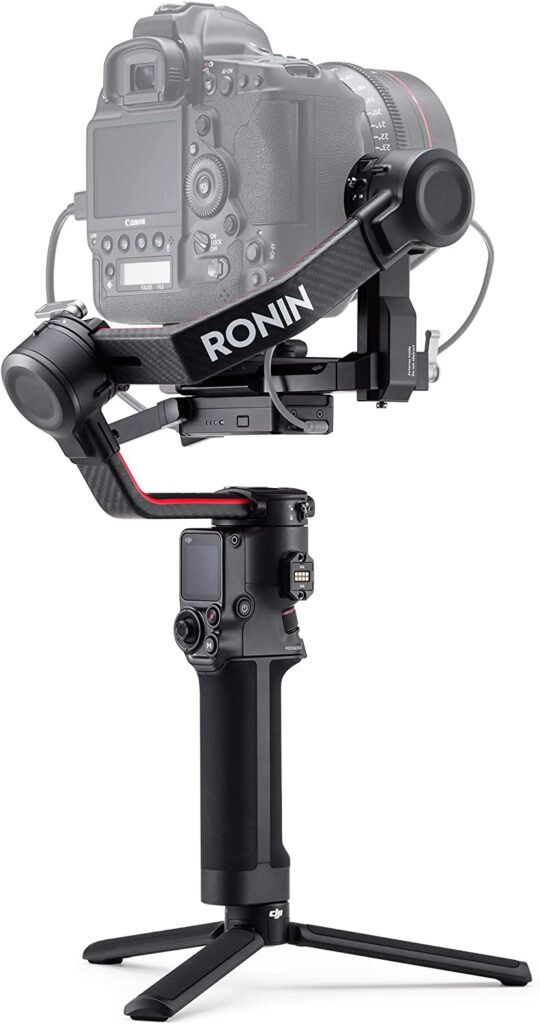
- Payload capacity: 4.5 kg (10 lbs)
- Battery life: up to 12 hours
- Pan Axis: 360°
- Tilt Axis: 280°
- Roll Axis: 340°
- Charging ports: USB-C, RSA port
- Supports DSLR cameras: Yes
- Supports smartphones: Yes
- Price: $849 / €739
Pros
- High payload capacity
- Long battery life
- Intuitive design
Cons
- High price point
- Additional accessories needed for some features
Zhiyun Crane 3S
The Zhiyun Crane 3S is another high-end gimbal camera stabilizer with a heavy payload capacity, making it ideal for professional filmmakers. Despite its size, it’s surprisingly portable and easy to travel with. The battery life is decent, and the built-in screen is a nice touch for quick adjustments on the go.
However, the learning curve can be steep for beginners, and the price may not be feasible for all filmmakers.
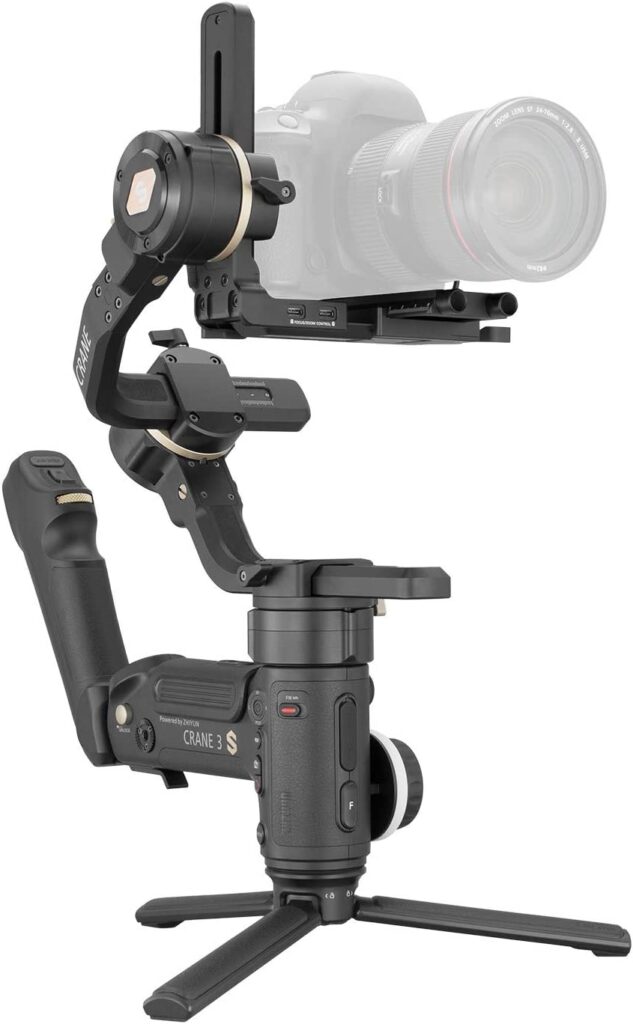
- Payload capacity: 6.5 kg (14.3 lbs)
- Battery life: up to 12 hours
- Pan Axis: 360°
- Tilt Axis: 330°
- Roll Axis: 360°
- Charging ports: USB-C, DC in/out, CAN in/out
- Supports DSLR cameras: Yes
- Supports smartphones: No
- Price: $1,149 / €999
Pros
- High payload capacity
- Modular design
- Advanced controls
Cons
- High weight and price point
- Complicated setup process
Moza Air 2
The Moza Air 2 is a mid-range gimbal camera stabilizer that offers impressive stability and versatility. It’s compact and lightweight, making it easy to pack for travel. The battery life is excellent, and the variety of shooting modes such as Inception Mode and Sport Gear Mode makes it a great choice for capturing dynamic shots.
However, some users have reported issues with the app and firmware updates, and the payload capacity may not be suitable for heavier camera setups.
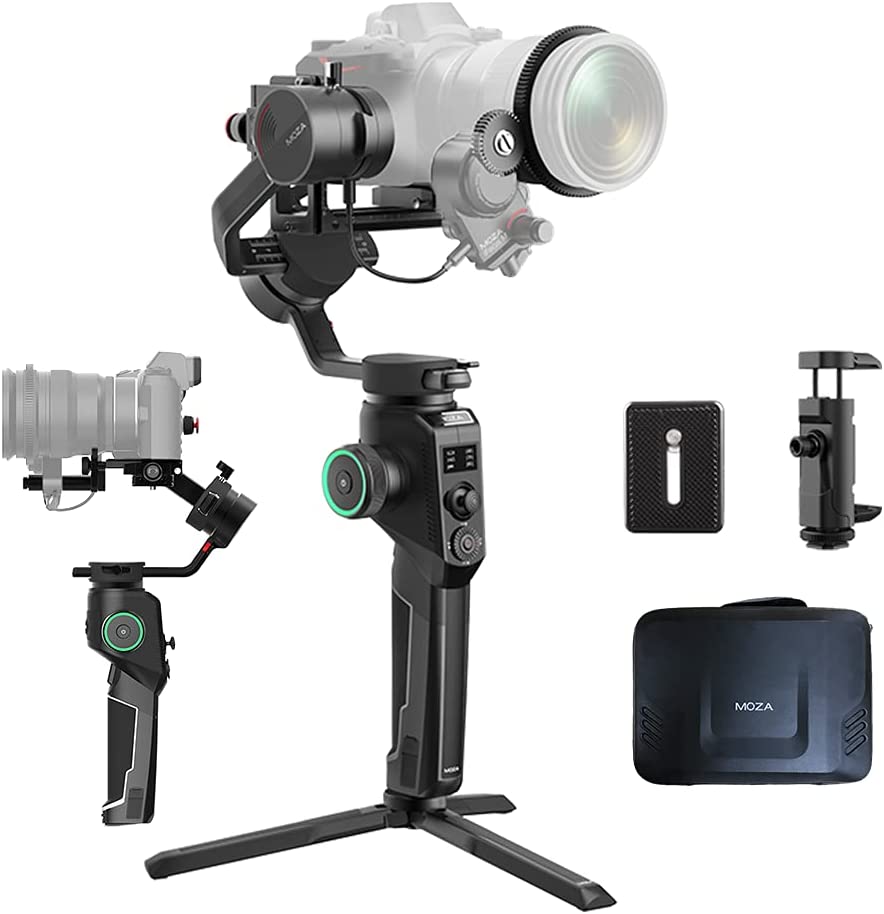
- Payload capacity: 4.2 kg (9.3 lbs)
- Battery life: up to 16 hours
- Pan Axis: 360°
- Tilt Axis: 360°
- Roll Axis: 360°
- Charging ports: USB-C, DC in, CAN out
- Supports DSLR cameras: Yes
- Supports smartphones: Yes
- Price: $599 / €519
Pros
- Long battery life
- Lightweight design
- Built-in follow focus system
Cons
- Compatibility issues with some cameras
- Limited range of motion
FeiyuTech AK4000
The FeiyuTech AK4000 is a budget-friendly gimbal camera stabilizer that still offers a solid range of features. It’s compact and easy to transport, and the battery life is decent for the price point. Their “8th Instune” software algorithm allows for smooth and stable footage, and the joystick control is intuitive for beginners.
However, the app could use some improvement, and the payload capacity is not as high as some of the more expensive models.
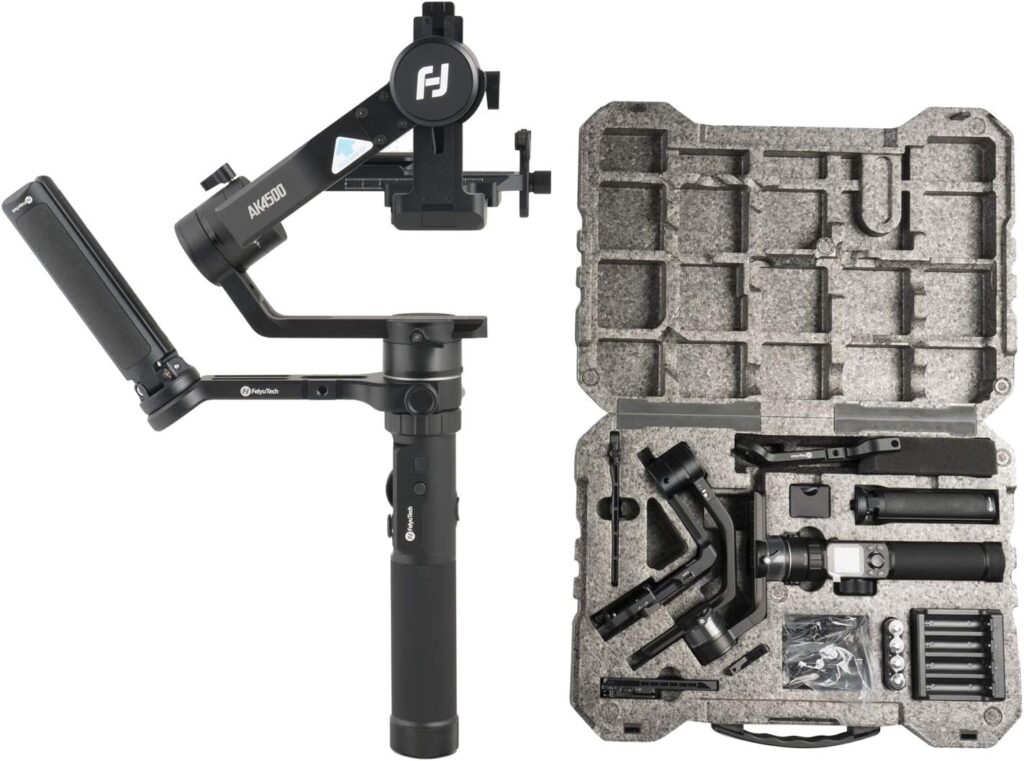
- Payload capacity: 4 kg (8.8 lbs)
- Battery life: up to 12 hours
- Pan Axis: 360°
- Tilt Axis: 230°
- Roll Axis: 360°
- Charging ports: USB-C, DC in, DC out
- Supports DSLR cameras: Yes
- Supports smartphones: Yes
- Price: $469 / €407
Pros
- Intuitive touchscreen interface
- Advanced stabilization algorithms
- Variety of shooting modes
Cons
- Limited battery life
- Relatively high price point
DJI Ronin-SC
The DJI Ronin-SC is a mid-range gimbal camera stabilizer that’s specifically designed for mirrorless cameras. It’s incredibly lightweight and portable, making it ideal for traveling. The battery life is good, and the app connectivity is reliable. The ActiveTrack feature is a standout, allowing you to easily track your subject while on the move. However, the payload capacity is limited, and the roll axis motor can be prone to overheating.
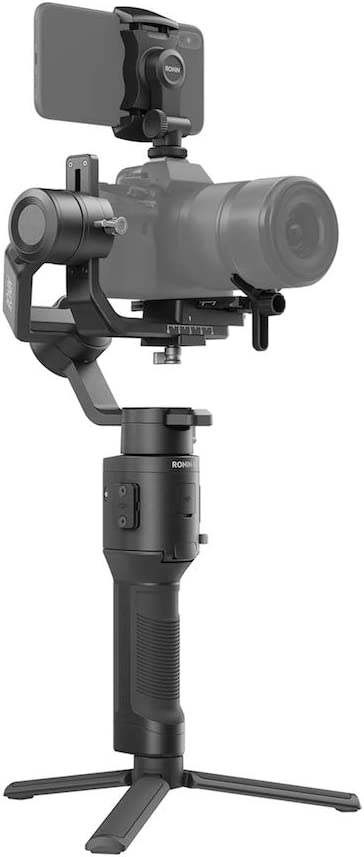
- Payload capacity: 2 kg (4.4 lbs)
- Battery life: up to 11 hours
- Pan Axis: 360°
- Tilt Axis: 230°
- Roll Axis: 305°
- Charging ports: USB-C, Camera Control Port
- Supports DSLR cameras: Yes
- Supports smartphones: Yes
- Price: $439 / €379
Pros
- Lightweight and portable design
- Easy-to-use controls
- Impressive battery life
Cons
- Compatibility issues with some cameras
- Limited range of motion
Zhiyun Crane M2 (Our top-rated Gimbal)
The Zhiyun Crane M2 is a compact and lightweight gimbal camera stabilizer designed for smartphones, action, and compact cameras. It’s highly portable and easy to use, with a user-friendly interface and joystick control. The battery life is impressive, and the variety of shooting modes makes it a great choice for various videography styles.
However, the payload capacity is limited.

- Payload capacity: 0.72 kg (1.58 lbs)
- Battery life: up to 7 hours
- Pan Axis: 360°
- Tilt Axis: 310°
- Roll Axis: 324°
- Charging ports: USB-C
- Supports DSLR cameras: No
- Supports smartphones: Yes
- Price: $269 / €239
Pros
- Versatile design for cameras and smartphones
- Long battery life
- Easy-to-use control system
Cons
- Limited range of motion
- Slower response time
Hohem iSteady MT2
Compared to the other gimbal camera stabilizers we reviewed in this article, the Hohem iSteady MT2 distinguishes itself with its innovative AI Tracker and Magnetic Fill Light, which significantly enhance the videography experience.
As the name hints, the AI Tracker automates the subject tracking, ensuring that the camera focuses steadily on the moving subject, making it ideal for dynamic shooting scenarios – something we recently tested during our road trip in Morocco.
The Magnetic Fill Light is another standout feature for low-light environments, providing an extra light source to ensure quality footage even in challenging lighting conditions.
At just 0.55 kg, the stabilizer is travel-friendly, making the Hohem iSteady MT2 an interesting tool for videographers looking to capture smooth and well-lit footage while traveling.
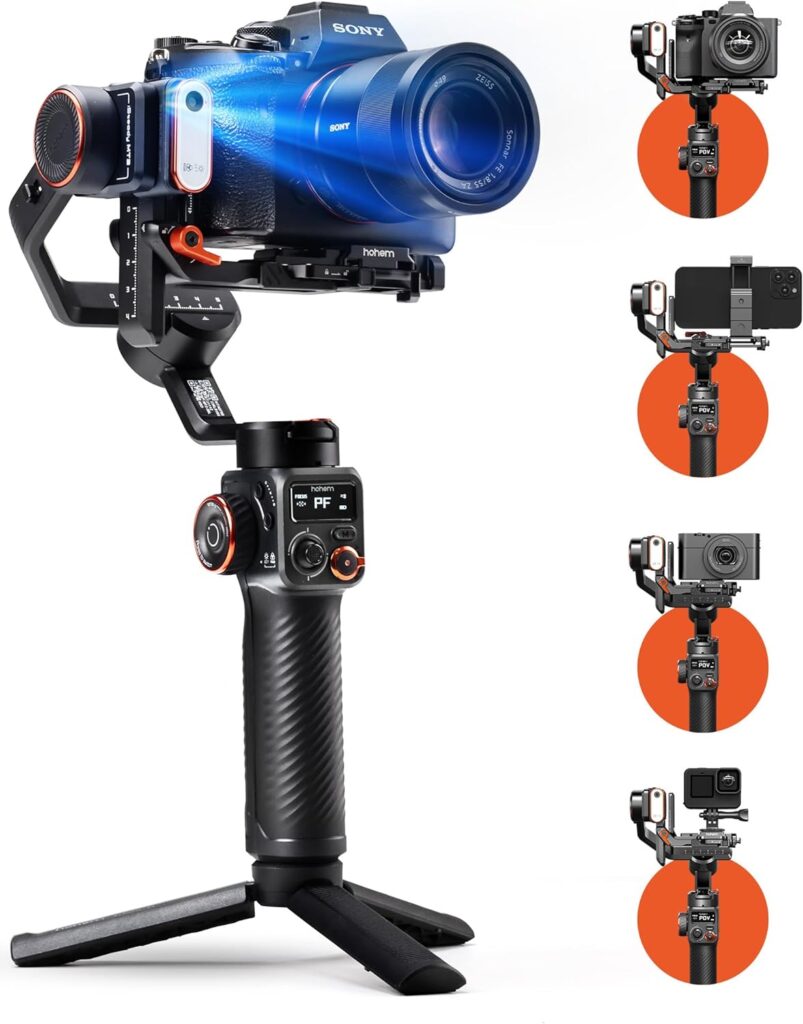
- Payload capacity: 1.2 kg (2.7 lbs)
- Battery life: up to 17 hours
- Tilt Axis: 290°
- Roll Axis: 320°
- Supports DSLR cameras: Yes
- Supports smartphones: Yes
- Price: $263 / €240
Pros
- AI Tracker
- Magnetic Fill Light
- Lightweight
- AI Custom Composition and Gesture Control
Cons
- Limited Payload capacity (1.2kg)
- Balancing and rebalancing might be tricky
Other sites also recommend …
As we can’t test every gimbal released in the market so, we thought we’d include some of the gimbals that some other reputable sources have mentioned. Keep in mind that most of these other sites included the same recommendations that we have given above.

